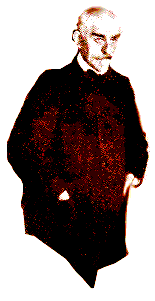
|
|
| Joris-Karl Huysmans |
BACKGROUND & MINI-PROFILE
J.-K. Husymans was the pseudonym of the French novelist and art critic Charles Marie Georges Huysmans. For most of his life, he held a post as a government official in the Ministry of the Interior during which he also wrote several novels. Huysmans's first novels, Marthe (1876), Les Soeurs Vatard (1879), Les Soirées de Medan (1880), and A Vau L'Eau (1882), were considered to be in the style of the Naturalism and Realism school associated with Émile Zola. |
DATE of BIRTH PLACE of BIRTH: DATE of DEATH: PLACE of DEATH: WHERE BURIED: |

À Rebours (Against Nature), published in 1884, was a break with the Naturalistic style and is considered one of the quintessential works of the Fin de Siècle and Decadent period. He followed this novel with En Rade [Becalmed] (1886), where the disillusioned hero futilty seeks spiritual retreat; Là-Bas [Down There] (1891), where the novel's hero, Durtal, is drawn into an exploration of the history of Gilles de Rais, the occult, and Satanism; and En Route (1895), a novel in which the hero Durtal from Là Bas retires to a Trappist monastery. Not long after writing En Route, Huysmans resigned his post in the government and retired himself to a house near a Benedictine monastery where his subsequent novels (among them La Cathédrale, La Bièvre et Saint Séverin, Sainte Lydwine de Schiedam, De Tout, L'Oblat, and Les Foules de Lourdes), often featuring his somewhat autobiographical hero, Durtal, dealt with his own deepening commitment to Catholicism.TRIVIA, TIDBITS, GOSSIPBoth À Rebours and Là-Bas have often landed on banned and censored book lists. À Rebours is the book referred to in Oscar Wilde's The Picture of Dorian Gray called "the strangest book that he had ever read." The reference was brought up at Wilde's infamous trial in 1895, and the prosecutors used Wilde's familiarity with the book to help put his morality into question. The inspiration and research for Là-Bas coincided with a widespread interest in occult subjects that occurred at the end of the 19th century and brought Huysmans into contact with some contemporary occultists, among them Naundorffists Oswald Wirth and Stanislaus de Guarita. He also began a correspondence/acquaintance with Abbé Boullan, a defrocked priest who had set up the Church of Carmel, where Huysmans later witnessed some of the rituals he described (some say erroneously) in his novel. Some of the occultists were upset at the publication of Là-Bas and warned the author he would be subject to occult attack, which prompted Boullan to give Huysmans some "exorcism paste." |
|
LAURELS & BARBSHusymans' subjects and stylistic changes over his long career inspired much commentary from his contemporaries as well as drawing condemnation from the Catholic church at the time, although the Catholic church found his later novels worthwhile, which is probably what inspired a favorable and interesting mention found here in The Catholic Encyclopedia. This mention includes a tidbit about how in later life he suffered an affliction that was treated by sewing his eyelids shut. The Catholic Encyclopedia says of this: "In his piety he believed that these eyes, with which he had seen so many beautiful things and through which he had received so much pleasure, were taken from him by way of enforcing penitence." When À Rebours came out, Zola was disappointed that Husymans had broke with the Naturalism style, calling it "a terrible blow for Naturalism." But of En Rade, Zola was pleased and called it "his most intense work." André Breton called En Rade an "Anthology of Black Humour." |
|
SELECTED QUOTES"...artifice was considered by Des Esseintes to be the distinctive mark of human genius." - from À Rebours "Having rejected all these colours, he was left with only three: red, orange, and yellow. "I learned long ago that there are no people interesting to know except saints, scoundrels, and crackpots." - from Là-Bas "With his hooked paw, the Devil drew me to God." |
SELECTED LINKSlast updated 3/19/00 |